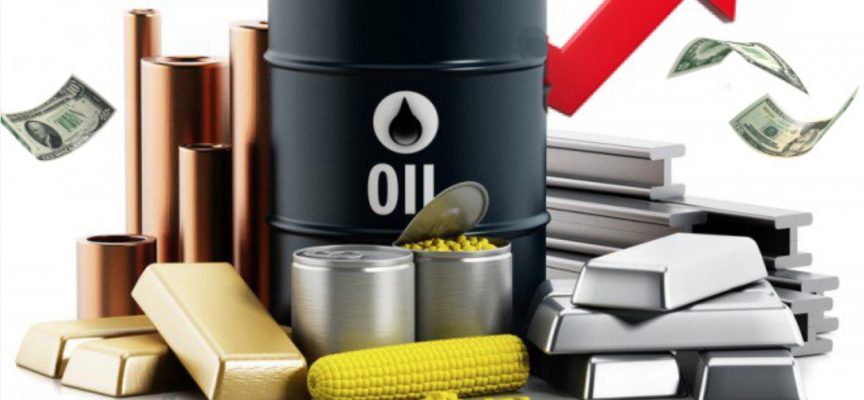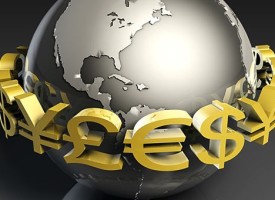Silver and copper had major upside breakouts today, plus a look at stagflation.
Silver
October 14 (King World News) – Graddhy out of Sweden: We are now having a first go at the longer term trend line. As said, the setup with that classic pm textbook undercut low below Sept 2020 21.81 wick, together with holding trend lines on weekly, was a perfect setup. And US dollar probably topping here does not hurt.
Silver Has Broken Above Downtrend Line
Copper
Graddhy out of Sweden: Said two weeks ago that it was showing great strength by holding at black support line. And yesterday we got the purple falling wedge breakout on daily. This is important as copper is the leading base metal. As said for 2 years now – we are in for inflation.
Massive Upside Copper Breakout Today!
Stagflation?
Alasdair Macleod: Describing evolving inflationary conditions as stagflation misses the point about today’s inflationary conditions. Stagflation was originally used only in the context of excessive wage increases not matched by improved trading prospects. Just in that narrow sense, today we are experiencing stagflation.
But in the wider context inflationary conditions being described as stagflation are not stagflation at all. They are the consequences of increased money supply undermining the purchasing power of currencies —an extremely dangerous economic condition that, unless it is fully checked, leads to the destruction of a fiat currency.
In the UK and elsewhere politicians are claiming that higher wages for the low paid are needed to get them back to work. Without an increase in productivity, it amounts to a recommendation in favour of stagflation. But in measuring stagnating production, politicians and economists alike are being misled by estimates of individual productivity by the OECD, which produces the basic statistics.
This article demonstrates the incorrect assumptions behind the OECD’s calculations on productivity and why it is not the function of governments to attempt to manage it. If governments are to do anything positive, it should be to cut employment taxes and stop interfering.
The reader less interested in the abuse of labour and production statistics might like to skip the section on the OECD’s approach to productivity for the brief update on the wider evolution of global hyperinflation later in the article…
New interview from legend Doug Casey discussing gold, silver and
global chaos! To listen click here or on the image below.

Introduction
As the global economy descends into a hyperinflationary collapse, commentators who have yet to fully understand the dynamics of it are now becoming aware that price inflation looks like being rather sticky and far removed from Jay Powell’s hopeful description of transient.
Still on the back foot, these rear-view mirror policy drivers are beginning to see it as evidence of stagflation. It is a condition which neo-Keynesians find contradictory, taken to describe a combination of inflation and a stagnating economy. But this takes the word out of its original context. I should know, because it was first used by Iain Macleod when he was a Member of Parliament and shadow chancellor in the Conservative opposition on 17 November 1965. Iain happened to be my father’s elder brother, so was he was my uncle.
The following is an extract from Iain’s speech in the Commons that day. I extract as much as I do to give it its proper context:
“We now have the biggest gap between productivity and earnings of any time in modern economic history. Certainly, history was being made. The index figure of industrial production at 133 for January—revised on the latest figures to, I think, 134; and for December it is down to 131—is certainly history. I can find no period—and I have checked this all the way back, with the possible exception of 1952—when in 13 years there was a year when the gap was so wide between what we should be doing, and we were in fact doing.
“We now have the worst of both worlds —not just inflation on the one side or stagnation on the other, but both of them together. We have a sort of “stagflation” situation and history in modern terms is indeed being made. There is another point behind the figures. As I say, production has fallen by 1 per cent. or ½ per cent. while incomes have gone up, perhaps, by 8 per cent. This can result only in two things happening in the months ahead; either a considerable increase in our import bill to meet the increased consumer expenditure or a very real rise in our prices.”
So, there we have it. The reference was specifically about the combination of stagnating production and wage inflation. This is the condition that is, ironically, today being promoted by the Conservative government, led by Boris Johnson lauding higher wages without the immediate production to match. That’s just a vague hope for the future. There really is no difference between the government sanctioning higher wages in the predominantly nationalised industries without improved productivity in 1965 and the wages situation today. The language only is changed. Boris is chasing a mirage of economic transformation with industry somehow managing to accommodate higher wages and remain in business…
ALERT:
Billionaire and mining legend Ross Beaty, Chairman of Pan American Silver, just spoke about what he expects to see in the gold and silver markets and also shared one of his top stock picks in the mining sector CLICK HERE OR ON THE IMAGE BELOW TO HEAR BEATY’S INTERVIEW.

It was not, as is commonly supposed, a wider description for an economy which is stalling while consumer prices are rising. But to many observers that is what stagflation has become. It is now a portmanteau word for a portmanteau situation — the latter being an inadequate description for the consequences of earlier monetary stimulation. It is a half-way house on the road to discovering the true hyperinflationary threat faced by us all on a global scale, if as seems likely democratic governments have become so addicted to unfunded expenditure that they cannot stop relying on it.
Stagflation is commonly associated with the 1970s. But as we have seen, it was applied to an earlier condition a whole credit cycle before price inflation threatened to escalate from 1972 onwards.
Another aspect was the different monetary situation, best illustrated with American statistics. Bank credit in the US expanded in the 1970s more rapidly than in 2010—2021, but since the financialisation of the economy this comparison is rendered useless due to the development of shadow banking, which in terms of credit creation cannot be defined statistically. A better indicator is the Fed’s base money, and Figure 1 shows how base money has grown since 2005, compared with its growth between 1965—1981.
From 1965—1981, US base money grew 191%, while from 2005 to date it has grown 716%. On its own, the massive increase in base money does not trigger a hyperinflation of prices: that is down to changing public perceptions of the purchasing power of the currency they use for day-to-day transactions. But members of the public are more likely to appreciate a link between measures of narrow money, such as a central bank’s base, than a link with bank credit, particularly when you bear in mind that even financially educated investors don’t understand how bank credit is created and what the effects are likely to be.
Suffice it to say, that in the history of banking and deposit creation a cycle of bank credit expansion and its subsequent contraction is identifiable and can be explained. And the empirical evidence is that the cycle of bank credit has less of an impact on prices over its boom-and-bust duration than increases in base money.
That being the case, we can assume that a comparison between the prospects for a loss of purchasing power for currencies today with the situation when so-called stagflation ruled in the 1970s is misleading. Today, the conditions exist for what economic historians describe as hyperinflation, but more accurately described is a substantial or total collapse in the purchasing power of contemporary currencies.
The productivity myth
We now turn our attention to the error of the state determining individual productivity, which apart from climate change and supposedly temporary logistical foul-ups was a focus for government policy at this week’s G20 meeting of finance ministers and central bank governors in Washington.
As shown above, the term stagflation was originally only applied to a condition whereby wages rise unsupported by output. Other than the cost of labour, prices were not even mentioned. Today, we see that in a wider inflationary context, similar conditions do exist for the original definition of the word. Labour costs are inflating in all jurisdictions while output appears to be stagnating. As mentioned in the introduction, Boris & Co appear to be excusing it by claiming that the UK must transition from a low-wage, low-productivity economy to a higher wage more productive economy, the latter condition an indefinite prospect in the future. Doubtless, other national leaders are or will be making similar claims in their jurisdictions.
Every now and then, there’s a rash of commentary on national productivity. And for the British, poor productivity is a contemporary hangover of Brexit angst. The OECD, the Treasury, the Bank of England and Remainers are all claiming the average Brit’s productivity level is woefully inadequate and goes to show how much they need the certain comfort of being in the EU…
To learn which company billionaire Eric Sprott bought a
$10 million stake in click here or on the image below

In 2017, the OECD came out with a paper about the economic consequences of Brexit, even recommending Britain should hold a second referendum to reverse the Brexit decision. To back up its analysis it claimed Britain’s labour productivity was at a standstill, while that of France, Germany the United States and the OECD averages of all nations were improving.
Regular readers of my articles will know that I disparage statist statistics, averages, and the neo-Keynesian analysis that goes with them. The econometricians’ concept of productivity is a prime example of why statistics derived from questionable information should be disregarded entirely. The OECD, which is the main source of the productivity statistics quoted by politicians, appears to use statistics not in a genuine search for the truth, but as a cheerleader for government management of the economy. Being based in Paris this institution is particularly sympathetic to European statism.
This is the organisation behind official international analysis of labour statistics, while being funded entirely by self-interested governments. However, on the face of it, productivity should be uncontentious, and hard to criticise. GDP divided by the number of hours worked is a simple metric. But it is deceptively misleading.
The OECD’s approach to productivity
The OECD’s brief paper, Defining and measuring productivity, quotes Paul Krugman:
Productivity isn’t everything, but in the long run it is almost everything. A country’s ability to improve its standard of living over time depends almost entirely on its ability to raise output per worker.
Krugman implies in this quote that productivity is a function of national policy and therefore should override the interests of the employer. This is plainly in contravention of the facts: apart from the too-frequent instances of employers who seek state subsidies to bridge gaps in productivity, an employee only adds value if he or she is employed by an employer for profit. It is up to the employer to make that decision, not government. That the OECD headlines Krugman’s view confirms the OECD’s economics are in line with his thinking.
From here, the statistical errors embark, starting with the relevance of GDP. GDP is designed to capture final consumption and underplays the production of goods of a higher order, such as factory machinery and services inputs, by not recording the intermediate steps in production. This important point is now recognised in the US by the introduction of a relatively new statistic, gross output (GO)…
Keith Neumeyer Just Predicted $100+ Silver And $3,000 Gold! TO LISTEN CLICK HERE OR ON THE IMAGE BELOW.
GO is reported quarterly by the Bureau of Economic Analysis, and it is almost double the GDP number. Therefore, in the US, GDP per hour worked is half the realistic measure of the relation between production output and labour costs in private sector industries. GO confirms that using GDP in a productivity formula is outrageously misleading. But the OECD does not estimate GO, and it should be noted that different countries have varying degrees of intermediate production, which makes it impossible to compare them on a like-for-like basis anyway.
We can easily expose as baloney the concept of labour productivity in our daily affairs. For example, if you are in retailing, you may judge your sales staff to be productive, because they produce sales. But most of the footfall in your store probably has nothing to do with the salesman’s skills. The window-dresser may or may not have contributed, and are the cleaners and accountants productive, along with the warehouse staff and the van drivers who deliver to the store? Taken individually, they are a cost, difficult or impossible to relate individually to final sales, which makes up GDP. Therefore, running a business is about teams of people with complementary inputs, and to record the production of individuals in GDP terms becomes senseless. In this context GO is a more realistic measure.
By intervening in private sector production, the state renders it less efficient by imposing taxes and regulations, and interfering with the relationship between employer and employee. As a form of capital deployed in production, labour becomes inflexible. The state doesn’t want businesses to lay off workers when business calculations go awry. Instead, the state obstructs the redistribution of labour by subsidising the uncompetitive businessman. Governments also penalise profitable businesses by taxing profits and in many cases employment itself.
Furthermore, different industries deploy their various forms of capital in different ways, so within statistical averages, as part of the whole the contribution from human effort varies considerably. And a mechanic on an automated production line supervising expensive robots cannot be averaged with a floor-sweeping cleaner.
The government’s own GDP contribution must be excluded from any productivity calculation, as it is a resource drain on more efficient production in the private sector. The services provided by the state are not demanded by consumers but imposed upon them…
Insiders just invested another $56 Million in this 12 million ounce
Canadian gold company! TO FIND OUT WHICH ONE
CLICK HERE OR ON THE IMAGE BELOW.
The problem with statistics such as productivity is that everyone thinks they mean something. And, of course, the political class, including finance ministers, stand for nothing and fall for anything. That notwithstanding, let us ignore the fact that this econometric gem is only paste, and recast the figures into something more meaningful. Something that a businessman might find useful as a basis for comparison in the quest for the best jurisdiction to establish his business. Something that will guide him about whether he should relocate from Britain to mainland Europe as the OECD still believes should be the economic consequence of Brexit.
For this purpose, we shall select four countries in Europe from the OECD’s database, including the UK. In 2019 (the most recent OECD calculations), GDP per hour worked in US dollar equivalents in the order of most productive were France $67.50, Germany, $66.40, UK $58.40, and Italy $53.40. For what it’s worth, the UK lags the euro area average ($59.5) and particularly its near-neighbours, such as Belgium and The Netherlands. And it is not much better than the OECD average of $54.5: hardly the position to be in for a leading advanced nation.
These are the OECD figures upon which successive British finance ministers have based their beliefs about how unproductive their taxpayers are, and if only they could be exhorted to work more productively, tax revenues would improve. For that is the state treasurer’s real interest in the matter.
A more sensible approach is to look at productivity from a businessman’s point of view. It is out of his sales revenue that he must pay both employment taxes and wages for his employees. When reverse-engineering the OECD’s figures, we must also remove government, because our quest is to focus on the private sector. Then we must deduct the unemployed to arrive at the number employed. Table 1 quantifies the private sector workforce in 2019.
It’s worth noting that there are different ways to count government employees, and that France and Italy in particular have significant industries under state control whose personnel are not included as government employees.
Next, we must derive private sector GDP per private sector employee. This matches the adjustments to the work force in Table 1 with the private sector’s GDP. GDP and the state’s share of it is for calendar 2019, before government spending and therefore their share of GDP increased due to the pandemic, distorting their involvement in the economy. This is shown in Table 2.
Our Mr or Ms Average is held responsible for producing a share of GDP which is lowest in France, and highest in the UK. Who would have believed it! The OECD told us that the French employee was most productive, followed by Germany, then the UK. And Italy was, well, Italian. The OECD’s calculations have fallen at the first fence.
However, to employ Mr and Ms Average a salary must be paid along with social security and employment taxes before a business hopefully profits from his or her labour. This is our final adjustment in our quest to seek more relevant figures from the businessman’s point of view. The result is shown in our last table, Table 3.
Obviously, these figures are far from a true statement of productivity. As mentioned above, if the EU produced figures for GO, including intermediate processes as well as final values for goods, return per employee would make more sense. Germany, with its strong manufacturing base is probably most understated, while Italy and France less so. Britain may be somewhere in the middle —similar perhaps to the US at nearly twice GDP. And even France’s businesses could be shown to employ human resources profitably, barely perhaps.
The conclusion of this exercise is that the average businessman employing the average employee measured by average GDP per employee gets the best return on his investment in human capital in Italy, followed by the UK. The application of GO instead of GDP would almost certainly change that order into Germany and the UK being the most productive locations, and France and Italy the least attractive. If he has a predilection for France or Italy, a businessman better secure advantageous terms from the government for the life of his investment. And on other factors, such as language, culture, and the lack of parochial nationalism when it comes to business ownership, Britain even beats Germany, hands down. Perhaps that’s what drives manufacturers of international vehicle brands, including those of Germany, to choose Britain to base many of their production facilities.
Using the OECD’s own figures, recast to reflect commercial reality, the results deny the OECD’s own conclusions. When constructing the tables herein, I found significant variations in the statistics from different sources, and applying different exchange rates to costs has an additional statistical impact.
With its large cash-based agricultural sector, France’s GDP must be understated by not adequately recording the role of sole traders in its rural areas. And in Italy, as is the case elsewhere to less significant degrees, there are huge variations in average salaries, not only in different industry sectors, but regionally as well.
The purpose of the tables recast above is to give only the roughest of approximations of employee productivity. Human capital, being employed to do many different things, cannot be measured by anyone, except by whoever pays the salaries. And additionally, the OECD approach encourages politicians and mathematical economists to ignore the impact of employment taxes. It is here that the UK scores relatively well and France is a disaster, reflected in perpetually high unemployment because it is uneconomic for many workers to be employed.
Instead of criticising the private sector for being unproductive, it is surely more relevant for governments to look at their own burdens on production and act accordingly. And for UK politicians to claim that higher salaries will make the nation wealthier displays ignorance of the commercial facts based on misleading statistics. This was what stagflation was originally about: the payment of wages not matched by production. And that is what it should be confined to today, based on a proper understanding of labour economics.
Additional consequences of monetary inflation
We now turn to the wider consequences of earlier and current monetary inflation, which must not be confused with the original application of the stagflation term. Stagflation suggests a less serious inflationary problem than the dangerous potential for a hyperinflation of prices. Far from recognising the real danger, it suggests a problem that is retrievable, where things don’t get totally out of government control and that further inflation of prices is extremely unlikely. Perhaps, they believe, that the problem will resolve itself in time, proving after all, as the IMF states in its latest World Economic Outlook that “…amid high uncertainty, that headline inflation will likely return to pre-pandemic levels by mid-2022 for the group of advanced economies and emerging and developing economies”…
ALERT:
Legendary investors are buying share of a company very few people know about. To find out which company CLICK HERE OR ON THE IMAGE BELOW.
 Sponsored
Sponsored
The underlying reason for rising prices is illustrated in Figure 1, which showed that since 2005 US base money has increased over seven-fold. It has become the principal means by which the government deficit is financed, and with the total absence of any suggestion of cutting or even freezing government spending, we can only assume that the impetus behind rising prices will continue. It is not restricted to the US and its dollar. It is a script being followed by all other G20 member nations, with the possible exceptions of Russia and China.
It is not just a stagflation problem. Production issues are now far greater than labour costs on their own. While most of them should be familiar to readers, it is time to run a checklist.
- Labour shortages, caused by multiple factors, are leading to acute wage inflation in the industry sectors which are seeing unexpected consumer demand post-lockdown, while labour currently unemployed or tied up in less demanded production is proving to be unavailable. It is hoped that this stickiness will be resolved in time. But after receiving government subsidies to see them through covid lockdowns, for many there is a reluctance to return to work that can only be countered by reducing unemployment benefits. At a time of rising prices, this is proving to be impossible for democratically elected governments to do.
- The energy crisis is hitting households and is now the dominant issue. By pursuing a shift from fossil fuels to renewables, governments have brought an energy crisis upon their voters. Domestic fuel costs have soared ahead of the Northern Hemisphere winter and can only worsen. Wholesale natural gas prices have risen 270% since the Fed started its $120bn monthly QE programme in March 2020, heating oil by 360%, and gasoline blend-stock by 500%. Secondary effects are affecting food supplies, making intensive fruit and vegetable production in glasshouses uneconomic. Production of CO2, a by-product of waste management relying on energy inputs and vital to food packaging and carbonated drinks, has already required government subsidies to continue.
- The energy crisis is hitting all aspects of industrial production. Rising prices for electricity is affecting energy-intensive industries, rendering production of basic materials such as steel, aluminium, and cement uneconomic. China’s industrial production has been badly hit by power outages, which has prompted the government to instruct its electricity producers to obtain gas and coal on the international markets regardless of cost. This is going to put further pressure on global coal and natural gas prices. West Texas Intermediate oil is now over $80 per barrel, having risen four-fold since March 2020.
- Logistics problems continue. Experts now say that the world’s logistical foul-up will continue into next year for many months to come. Shortages of trucks have compounded the original post-pandemic problems, with container ports everywhere unable to clear backlogs. According to the Marine Exchange of Southern California, as of last Sunday 87 container ships were classed as in-port, meaning they are within 40 miles of Long Beach and Los Angeles, with 60 of them anchored. In the UK’s largest container port, Felixstowe, it is taking nine days to turn around a container ship compared with a normal time of two days. Product shortages are impacting industrial production badly, a problem made worse by just-in-time practices which have led to acute inventory shortages.
Figure 2 sums up the commodity supply problem and the effect on prices.
After a four-month consolidation, the price of this commodity ETF has broken above the dotted line and is rising again, indicating there is renewed pressure on producers to either successfully raise their output prices or go out of business. Unemployment will certainly rise, adding to government costs and reducing their tax revenues. Inflationary financing, which incidentally will fuel yet higher prices for all factors of production, is only just starting. And it must not be confused with stagflation.
At the G-20 meeting of finance ministers and central bank governors in Washington this week, delegates continued to insist these conditions will resolve themselves, in accordance with the IMF’s line quoted above, that “headline inflation will likely return to pre-pandemic levels by mid-2022 for the group of advanced economies and emerging and developing economies”. That they fully believe in it is however questionable. More likely, they are determined to discourage panic buying, in the knowledge that it will drive prices of consumer goods higher. But they will still hope that things will eventually normalise with headline inflation returning to pre-pandemic levels.
Also of importance…
Tier One Finds More High-Grade Silver
Tier One Silver Inc. has received high-grade channel sampling results from the recently identified Cambaya target at the Curibaya project in southern Peru. The results from the first 20 channel samples taken from Cambaya have defined an area one kilometre by 600 metres with highlights of 20 m of 293.8 grams per tonne silver equivalent, 11 m of 348.2 g/t AgEq, nine m of 438.8 g/t AgEq, two m of 1,852.8 g/t AgEq and two m of 1,111.9 g/t AgEq (true width of channel samples unknown). Channel samples were oriented perpendicular to veins and structures, when possible, as mapped in the field.
Peter Dembicki, president, chief executive officer and director, said: “The targeting at Curibaya continues to improve as we expand the high-grade silver-gold footprint. Our new Cambaya target, approximately one kilometre northeast of our current drilling, has advanced considerably with these channel sample results, which follow notably high-grade rock samples.
We are currently drilling beneath the previously reported high-grade channel samples from the Curibaya project within our main target area, and are looking forward to pending drill hole assay results in addition to over 30 pending channel samples from both the Cambaya target at Curibaya, as well as from our Hurricane silver project.” Tier One Silver, symbol TSLV in Canada and TSLVF in the US.
***ALSO JUST RELEASED: Gold Looks Ready To Shine CLICK HERE.
***ALSO JUST RELEASED: James Turk: Move In Gold & Silver Is Long Overdue – This Breakout Level For Gold Will Trigger Move To New All-Time High CLICK HERE.
© 2021 by King World News®. All Rights Reserved. This material may not be published, broadcast, rewritten, or redistributed. However, linking directly to the articles is permitted and encouraged.

















